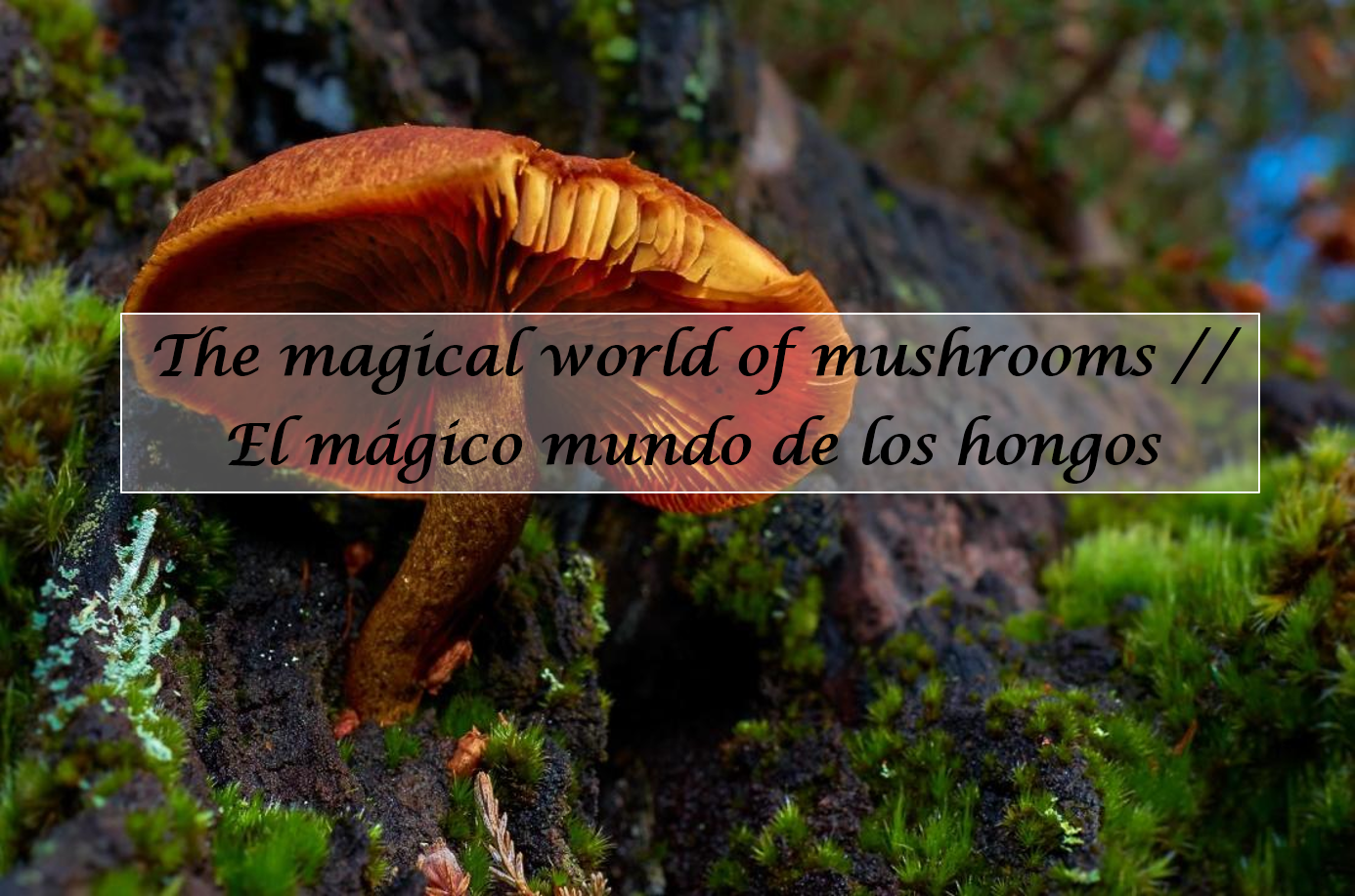
Fungi are organisms that are grouped in the Fungi kingdom, among which we commonly see in our daily lives are: mold, yeast and mushrooms. Before continuing to talk about fungi, I want to say a big hello to all my friends from the Hive platform and especially to the STEM community, this time I bring you a new topic that deals with Phytopathogenic Fungi
Los hongos son organismos que se agrupan en el reino Fungi, entre los que comúnmente vemos en nuestra vida cotidiana están: el moho, las levaduras y los champiñones. Antes de continuar hablándoles sobre los hongos, quiero darles un gran saludo a todos mis amigos de la plataforma Hive y en especial a la comunidad de STEM, en esta oportunidad les traigo una nueva temática que trata sobre Hongos Fitopatógenos
Unit 1. General and importance of fungi.
Tema 1. Generalidades e importancia de los hongos.
What are mushrooms?
They are different organisms from protists, plants and animals, but at the same time they share similarities. They are heterotrophs and do not have chlorophyll like animals and have a cell wall like plants, but which contains chitin instead of cellulose. In addition, they are individuals with eukaryotic cells, are made up of filaments, absorb nutrients and have sexual reproduction by spores and asexual. The science that studies fungi is called mycology.
The characteristics just mentioned are applicable for most fungi, with their exceptions such as Sclerotium, Rhizoctonia that do not produce spores and Saccharomyces that are not filamentous.

De izquierda a derecha: Pan con moho, levadura vista desde el microscopio y champiñones. Imagenes de dominio público:
¿Qué son los hongos? Son unos organismos diferentes a los protistas, plantas y animales, pero que a la vez comparten similitudes. Son heterótrofos y no presentan clorofila como los animales y poseen pared celular como las plantas, pero que contiene quitina en vez de celulosa. Además, son individuos con células eucariotas, se compone de filamentos, absorben los nutrientes y presentan un reproducción sexual por esporas y asexual. La ciencia que estudia a los hongos se llama micología. Las características que se acaban de mencionar son aplicables para la mayoría de los hongos, con sus excepciones como Sclerotium, Rhizoctonia que no producen esporas y Saccharomyces que no son filamentosos.
History
• In the history of man we see how mushrooms are present as in the case of the Romans, Greeks and Egyptians: they toasted with wine, they consumed bread with yeast and they considered fermentation as a gift from the God Osiris
• On the other hand, the Aztecs and Mayans performed religious rituals of using Psilocybe mexicana (Hallucinogen)
• For the year 1685 the Invention of the Microscope occurs, allowing the first studies related to systematic fungi
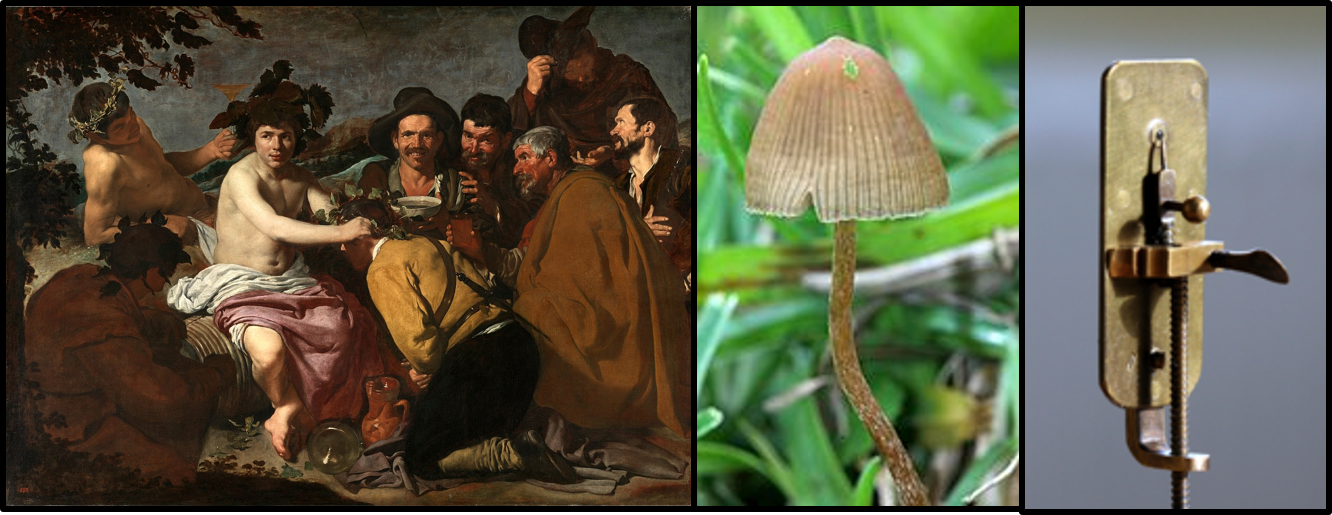
De izquierda a derecha los romanos brindado con vino, hongo Psilocybe mexicana y primer microscopio. Imagenes de dominio público:
• Another highlight in the story is the work of Pier ’Micheli 1729“ Nova Plantarum Genera ”(he is considered the father of Mycology). Likewise, another of the historical figures that stand out in mycology is Christiaan Persoon (1801) with his work "Synopsis Methodica Fungorum"
• One of the first publications in systematics and nomenclature was that of Elias Magnum Fries compiled in his work “Systema mycologicum” (1821-1832) with 3 volumes. It was also considered the Linnaeus of mycology.
• The first modern classification of fungi was made by Antoni De Bary (1853), who is the Father of Plant Pathology.
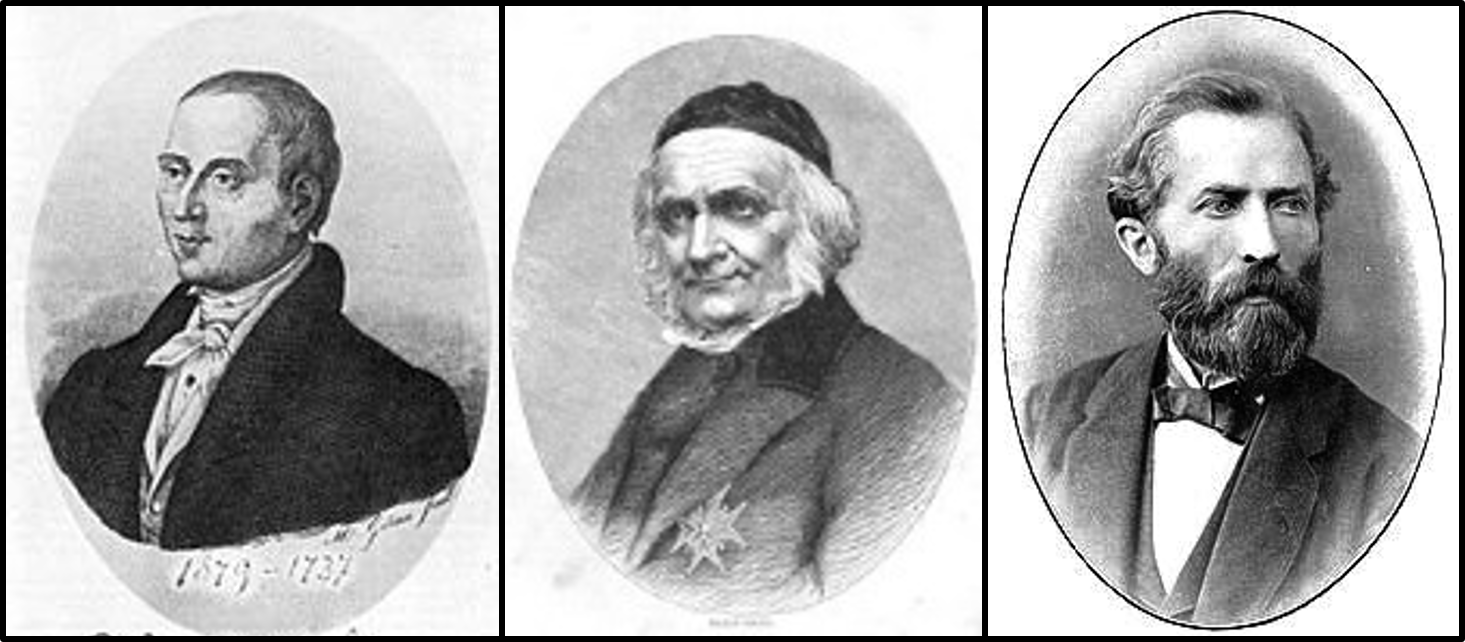
De izquierda a derecha Pier’ Micheli, Elias Magnum Fries y Antoni De Bary Imagenes de dominio público:
• Subsequently, the various advances in fungal morphology and pigment, Biochemistry and Physiology, Molecular Techniques and New Classification Systems began to emerge.
Historia• En la historia del hombre vemos como los hongos se encuentran presentes como en el caso de los romanos, griegos y egipcios: brindaban con vino, consumían el pan con levadura y consideraban la fermentación como un regalo del Dios Osiris • Por otro lado, los Aztecas y Mayas realizaban rituales religiosos de utilizando Psilocybe mexicana (Alucinógeno)• Para el año 1685 ocurre la Invención del Microscopio, permitiendo los primeros estudios relacionados con sistemática en hongos. • Otro de los aspectos resaltantes en la historia es la obra de Pier’ Micheli 1729 “Nova Plantarum Genera” (es considerado el padre de la Micología). Así mismo, otro de los personajes históricos que resaltan en la micología es Christiaan Persoon (1801) con su obra “Synopsis Methodica Fungorum”. • Una de las primeras publicaciones en sistemática y nomenclatura fue la de Elias Magnum Fries recopilado en su obra “Systema mycologicum” (1821-1832) con 3 tomos. Fue considerado además el Linnaeus de la micología. • La primera clasificación moderna de los hongos fue realizada por Antoni De Bary (1853), quien es el Padre de la Fitopatología. • Posteriormente comenzaron a surgir los diversos avances en morfología y pigmento de hongos, Bioquímica y Fisiología, Técnicas Moleculares y Nuevos Sistemas de Clasificación
Diversity
Fungi can live in diverse environments and be distributed throughout the world, including deserts and saline areas. They are terrestrial organisms and there are approximately 100 thousand species.
Diversidad. Los hongos pueden vivir en diversos ambientes y estar distribuido por todo el mundo, incluyendo desiertos y zonas salinas. Son organismos terrestres y existen aproximadamente unas 100 mil especies.
Importance of fungi
Fungi are of great importance in various areas, below we will mention some:
• Penicillium chrysogenum serves as penicillin (Antibiotic).
• Cephalosporium acremonium (cephalosporin: Antibiotic).
• Tolypocladium inflatum and Cylindrocarpum lucidum (cyclosporin: immunosuppressant).
• Ganoderma lucidum (antihemorrhagic, anti-inflammatory, diabetes, cancer, hepatitis, hypertension).
• Fomitopsis officinalis (antihemorrhagic)
• Biological controllers such as Trichoderma, Beauveria bassiana, Coniothyrium minitans parasitizing sclerotia of S. sclerotiorum, Paecilomyces lilacinus (controlling nematodes).
• There are also fungi used in food such as mushrooms (Boletus edulis), chanterelles (Lactarius deliciosus) and mushrooms (Agaricus bisporus).
• There are ornamental mushrooms, which are used for ornamental and aesthetic purposes.
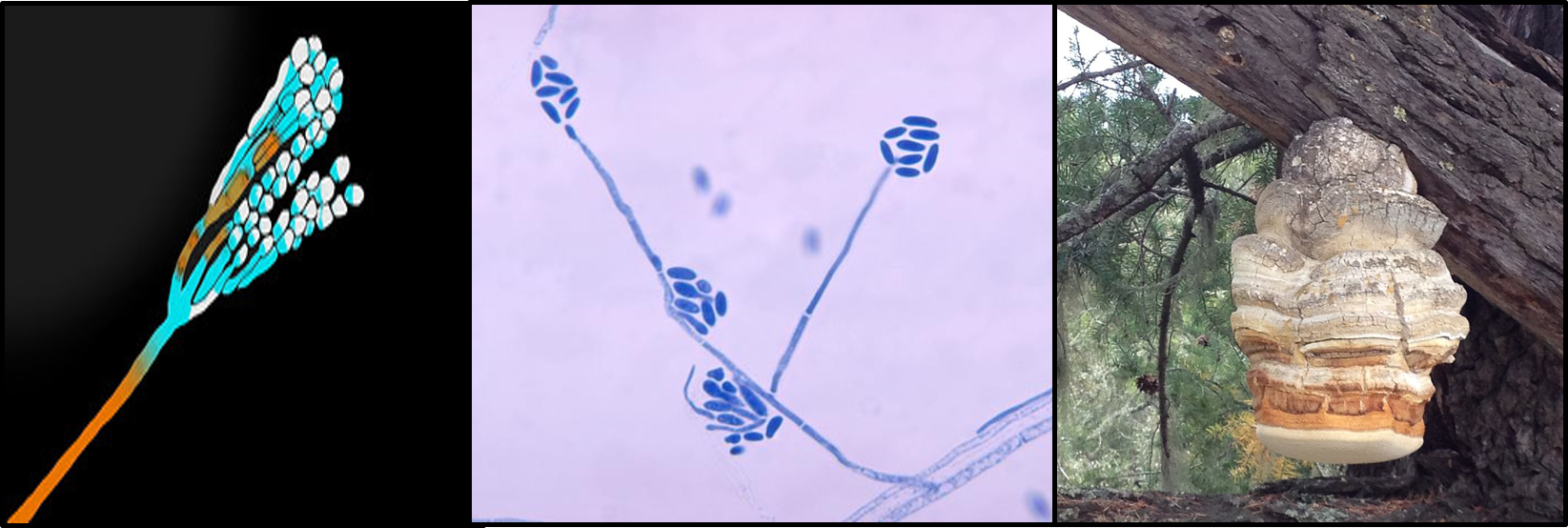
De izquierda a derecha Penicillium chrysogenum , Cephalosporium acremonium y Fomitopsis officinalis. Imagenes de dominio público:
Importancia de los hongos. Los hongos resultan de gran importancia en diversas áreas, a continuación mencionaremos algunas:• El Penicillium chrysogenum sirve de penicilina (Antibiótico). • El Cephalosporium acremonium(cefalosporin:Antibiótico). • Tolypocladium inflatum y Cylindrocarpum lucidum(cyclosporin: inmunosupresor). • Ganoderma lucidum(antihemorrágico, antinflamatorio, diabetes, cáncer, hepatitis, hipertensión). • Fomitopsis officinalis(antihemorrágico). • Controladores biológicos como Trichoderma, Beauveria bassiana, Coniothyrium minitans parasitando esclerocios de S. sclerotiorum, Paecilomyces lilacinus (controlando nematodos). • Tambien hay hongos utilizados en la alimentación como las setas (Boletus edulis), los mízcalos (Lactarius deliciosus) y los champiñones (Agaricus bisporus). • Existen hongos ornamentales, que son usados con fines ornamentales y estéticos.
Harmful fungi
There are harmful fungi for man, animals and plants such as:
• Aspergillus flavus can cause aflatoxin: cancer in animals, human liver
• Fusarium moniliforme causes Fumonisin. Esophageal cancer in humans, neurological diseases in horses.
• Candida albicans causes various pathologies in the skin, vagina, mouth, and scalp.
• Cryptococcus neoformans causes pneumonia
• There are also other fungi that can cause allergies, dandruff, mycosis, among other pathologies.
• 75% of plant diseases are caused by fungi.
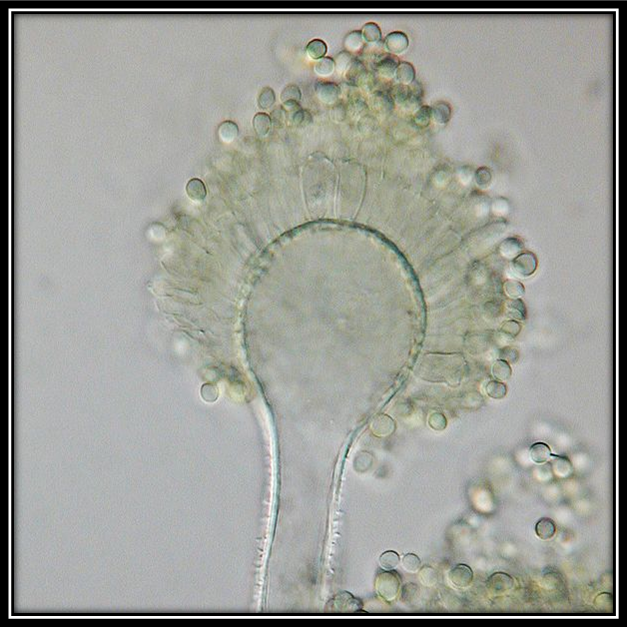
Aspergillus flavus. Imagen de dominio Público:
Hongos perjudiciales. Existen hongos perjudiciales para el hombre, animales y plantas como: • Aspergillus flavus puede causar aflatoxina: cancer en animales, hígado humano. • Fusarium moniliforme causa Fumonisin. Cáncer de esófago en humanos, enfermedades neurológicas en caballos. • Candida albicans causa diversas patologías en la piel, vagina, boca, cuero cabellido. • Cryptococcus neoformans causa Neumonía. • Además existen otros hongos que pueden causar alergias, caspa, micosis entre otras patologías. • 75% de las enfermedades en plantas son causadas por Hongos.
Literature consulted// Literatura consultada
- Agrios, G. 1999. Fitopatología. 2 ed. Academic Press. USA. Commonwealth Mycological Institute, CAB. 1985. Manual para patólogos vegetales. Lima, Perú. Pacific Press
- French, E. y Heber, T. 1980. Métodos en investigación Fitopatológica. CA. Costa Rica.
- Font Quer, P. 1979. Diccionario de Botánica. Ed. Labor. Barcelona.
La imagen de fondo de la presentación es de dominio público de:
¡Felicitaciones!
Te participamos que puedes invertir en el PROYECTO ENTROPÍA mediante tu delegación de Hive Power y así comenzar a recibir ganancias de forma semanal transferidas automáticamente a tu monedero todos los lunes. Entra aquí para más información sobre cómo invertir en ENTROPÍA.
Te invitamos a suscribirte a nuestra COMUNIDADEntra aquí para más información sobre nuestro trail., apoya al trail de @Entropia y así podrás ganar recompensas de curación de forma automática.
Puedes consultar el reporte diario de curación visitando @entropia.
Te informamos que el PROYECTO ENTROPÍA ha puesto en marcha un nuevo servicio, la Creación de cuentas nuevas de Hive, para más información puedes visitar este enlace.
Atentamente
El equipo de curación del PROYECTO ENTROPÍA
Thanks for your contribution to the STEMsocial community. Feel free to join us on discord to get to know the rest of us!
Please consider supporting our funding proposal, approving our witness (@stem.witness) or delegating to the @stemsocial account (for some ROI).
Please consider using the STEMsocial app
app and including @stemsocial as a beneficiary to get a stronger support.
Congratulations @maribelf! You have completed the following achievement on the Hive blockchain and have been rewarded with new badge(s) :
You can view your badges on your board And compare to others on the Ranking
If you no longer want to receive notifications, reply to this comment with the word
STOPDo not miss the last post from @hivebuzz: